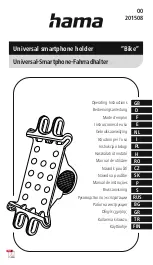
- MODEL 740 -
Page 11
BRAKE SHOE ADJUSTMENT
NOTE: Be sure to read preceding section on sliding hitch and latch adjustment
before proceeding to this step.
Brakes are set at factory, however, it may become necessary to adjust shoes after
the first season. The brakes incorporate a "Back-up" feature that makes it necessary
to rotate the wheels in the direction of
forward rotation only
when making adjust-
ments. Jack up each wheel, turn adjustment cog wheel located in slot on the brake
backing plate until brake shoes drag, then turn back cog wheel approximately
1-1/2 turns (20 cogs).
BRAKE BLEEDING
Use ONLY quality DOT-3 heavy-duty brake fluid.
If pressure bleeding equipment is available, follow the manufacturer's instructions in
bleeding the system.
MANUAL BLEEDING:
Fill master cylinder with fluid. Bleed rear brakes first (farthest from master cylinder).
Loosen the bleeder screw located in wheel cylinder one turn. The system is now
open to the atmosphere through a passage drilled in the screw. Securely install
bleeder hose to bleed screw on first wheel cylinder to be bled.
Submerge the loose end of bleeder hose in a glass container filled approximately
1/3 full with brake fluid to observe expelled air bubbles while stroking master cylinder.
NOTE: The bleed hose must have a snug connection at bleed screw and remain
submerged in brake fluid to avoid re-entry of air into the system.
Position a flat tool bar between master cylinder "L" bracket and housing (see
illustration) and pump master cylinder with long steady strokes. Continue to stroke
master cylinder until bubbles stop rising to surface of fluid in glass jar. Remove hose
and re-tighten bleeder screw
Repeat bleeding operation at each wheel cylinder. During the bleeding process,
replenish the brake fluid, so the level does not fall below the 1/2 full level in the
master cylinder reservoir. After bleeding is completed, make sure master cylinder
reservoir is filled and filler cap is securely in place.
WARNING
Saltwater, granular fertilizers and other corrosive materials are destructive to metal.
To prolong the life of a braking system used under corrosive conditions, flush the
actuator periodically with a high pressure water hose. Be sure to re-grease bearings
and oil all moving parts after the unit has dried. At the end of the season, when unit
is to be stored, remove the brake drums and clean inside the brakes. Pack wheel
bearings before drum is installed. CAUTION: Do not pack hub full of grease.
Excessive grease may leak into brake drums causing brake failure.
• 05-19-97
•
SERVICE
Summary of Contents for THE GRAIN TRAIN 740
Page 13: ... M O D E L7 4 0 Page13 NOTES SERVICE ...
Page 14: ... M O D E L7 4 0 Page14 220904 08 19 97 P ARTS ...
Page 18: ... M O D E L7 4 0 Page18 N O T E S P ARTS ...
Page 20: ... M O D E L7 4 0 Page20 220906 08 19 97 P ARTS ...
Page 26: ... M O D E L7 4 0 Page26 220905 P ARTS ...
Page 32: ... M O D E L7 4 0 Page32 250931 05 19 97 P ARTS ...
Page 38: ... M O D E L7 4 0 Page38 H Y D R A U L ICA U G E RO P T ION 08 19 97 220938 ...
Page 43: ... M O D E L7 4 0 Page43 ...












































